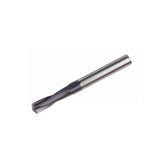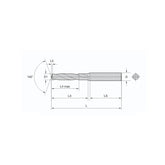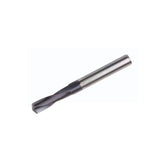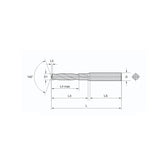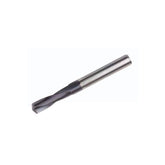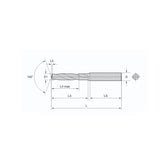How Much Do You Know About the Classification and Properties of Carbide Drill Bit Materials?
Carbide Drill Bit Materials
Classification, Properties, and Performance Characteristics
Cemented carbide materials dominate CNC machining tools. In some countries, over 90% of turning tools and more than 55% of milling cutters are made of cemented carbide. Cemented carbide is also a common material for manufacturing general-purpose tools such as drills and face milling cutters.
The cutting efficiency of cemented carbide tools is 5-8 times that of high-speed steel tools. The amount of metal removed per unit tungsten content is about 5 times greater than that of high-speed steel. Therefore, the widespread use of cemented carbide as a tool material is one of the most effective ways to utilize resources efficiently, improve cutting productivity, and enhance economic benefits.
1. Classification of Cemented Carbide Materials
By Chemical Composition
- Tungsten carbide-based: Include tungsten-cobalt (YG), tungsten-titanium-cobalt (YT), and rare carbide-added (YW) types
- Titanium carbonitride-based: Primarily composed of TiC with Mo and Ni binders
By Grain Size
- Conventional cemented carbide
- Fine-grained cemented carbide
- Ultra-fine-grained cemented carbide
GB/T Classification (2075—2007)
| Code | Description |
|---|---|
| HW | Uncoated carbide mainly containing WC, grain size ≥1μm |
| HF | Uncoated carbide mainly containing WC, grain size <1μm |
| HT | Uncoated carbide mainly containing TiC/TiN (cermet) |
| HC | Coated versions of the above carbides |
ISO Classification
| Class | Range | Characteristics |
|---|---|---|
| K class | K10-K40 | Highest hardness to maximum toughness |
| P class | P01-P50 | For various materials and conditions |
| M class | M10-M40 | Intermediate properties |
2. Properties of Carbide Drill Bit Materials
Cemented carbide materials use metal alloys as the matrix and carbides as the strengthening phase, possessing different physical, mechanical, and processing properties compared to tool steel and high-speed steel. Overall, they show increasing strength, hardness, and heat resistance, but decreasing toughness.
Hardness
Due to hard carbides (WC, TiC), cemented carbide is much harder than high-speed steel. Higher cobalt content decreases hardness. WC-TiC-Co alloys are harder than WC-Co. Adding TaC increases hardness by 40-100HV; NbC by 70-150HV.
Strength
Bending strength is 1/3-1/2 of high-speed steel. Higher cobalt increases strength. TiC content reduces strength. Adding TaC improves bending strength. Compressive strength is 30-50% higher than high-speed steel.
Toughness
Much lower than high-speed steel. TiC reduces toughness. Adding TaC can improve toughness by ~10%. Not suitable for strong impacts or vibrations due to lower toughness.
Heat Resistance
Can cut at 800-1000°C. TiC improves high-temperature hardness. Adding TaC or NbC improves high-temperature hardness. TiC addition enhances high-temperature strength.
Performance Comparison: Cemented Carbide vs. High-Speed Steel
| Property | Cemented Carbide | High-Speed Steel |
|---|---|---|
| Hardness | Much higher (HRA 89-93) | Lower (HRC 62-70) |
| Bending Strength | Lower (1/3-1/2 of HSS) | Higher |
| Thermal Conductivity | 2-3 times higher | Lower |
| Heat Resistance | 800-1000°C | 500-650°C |
| Tool Life | Several to dozens of times longer | Shorter |
Conclusion
The various characteristics of cemented carbide give it a much longer tool life than high-speed steel tools (several to dozens of times longer). It can multiply cutting speeds and machining productivity, and can process high-hardness materials that high-speed steel tools cannot machine.
The widespread use of cemented carbide as a tool material is one of the most effective ways to utilize resources efficiently, improve cutting productivity, and enhance economic benefits.
